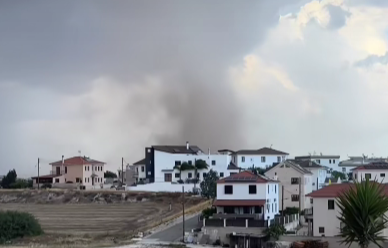
At the end of May 2025, the eastern Mediterranean region experienced notable tornado activity, with confirmed reports emerging from Turkey and Cyprus. These events, documented by the European Severe Weather Database (ESWD), highlight the often-underappreciated risk of tornadoes in this part of the world, a region more commonly associated with Mediterranean climate patterns rather than severe convective storms.
Cyprus encountered before the storms an early-season heatwave in late May 2025, with inland areas such as Nicosia recording temperatures up to 36.1°C on May 23. This was notably higher than the typical May maximum of around 28.2°C.
Turkey’s southern regions, particularly Antalya, experienced significant heat earlier in May 2025 before the arrival of storm systems. On May 24, Antalya recorded a high of 37.6°C, substantially exceeding the city’s average May maximum of 25.9°C.
Tornado Reports in Turkey
On May 29, 2025, the southern coast of Turkey, specifically the Antalya and Mersin provinces, witnessed a series of tornado-related phenomena linked to severe weather conditions over the Mediterranean Sea. The first reports came from the coastal town of Gazipaşa, located in Antalya Province (IF1.0). Observers documented a striking waterspout—an intense tornado over the water—forming offshore in the afternoon hours. Waterspouts are typically less intense than their land-based counterparts but can pose significant hazards, especially when they move onshore.
Shortly after, a similar waterspout was observed near Mersin, another coastal city to the east of Antalya. These waterspouts were associated with unstable atmospheric conditions, likely fueled by the warm Mediterranean waters and localized wind shear patterns. The occurrence of multiple waterspouts in such a short span points to an active convective weather system sweeping across the southern Turkish coast.
What made the situation particularly noteworthy was the transition of a waterspout from Gazipaşa onto land. This landfalling tornado caused reported damage to structures such as roofs and greenhouses, underscoring the destructive potential when waterspouts move ashore. While classified as relatively weak compared to tornadoes in traditional tornado-prone regions like the US Midwest, these events serve as a reminder that even Mediterranean coastal areas can face severe weather risks.
Tornado Event in Cyprus
In Cyprus, a brief but impactful tornado was recorded on May 29 in the Larnaca District near the village of Kalokhorio. This tornado was classified as a weak land tornado, with an intensity rating of IF0.5 on the International Fujita scale—a scale used to estimate tornado strength based on damage assessment. Despite its relatively low intensity, the tornado caused minor damage to roofs, demonstrating that even weaker tornadoes can have tangible effects on communities.
Meteorological Context
The tornado activity in Turkey and Cyprus during this period can be linked to a combination of atmospheric dynamics typical of late spring in the eastern Mediterranean. Warm sea surface temperatures provide the necessary moisture and instability, while localized wind shear and lifting mechanisms—such as upper-level troughs or surface fronts—can trigger rotating updrafts essential for tornado formation.
Conclusion
The late May 2025 tornado events in Turkey and Cyprus underscore the variability and reach of severe convective weather phenomena beyond traditional hotspots. While waterspouts and weak land tornadoes may not command headlines like their more powerful counterparts, they nonetheless pose genuine risks to life and property.

A tornado near the village of Kalokhorio, Cyprus, on 29. May 2025. Source: https://www.facebook.com/reel/741730108418269


























